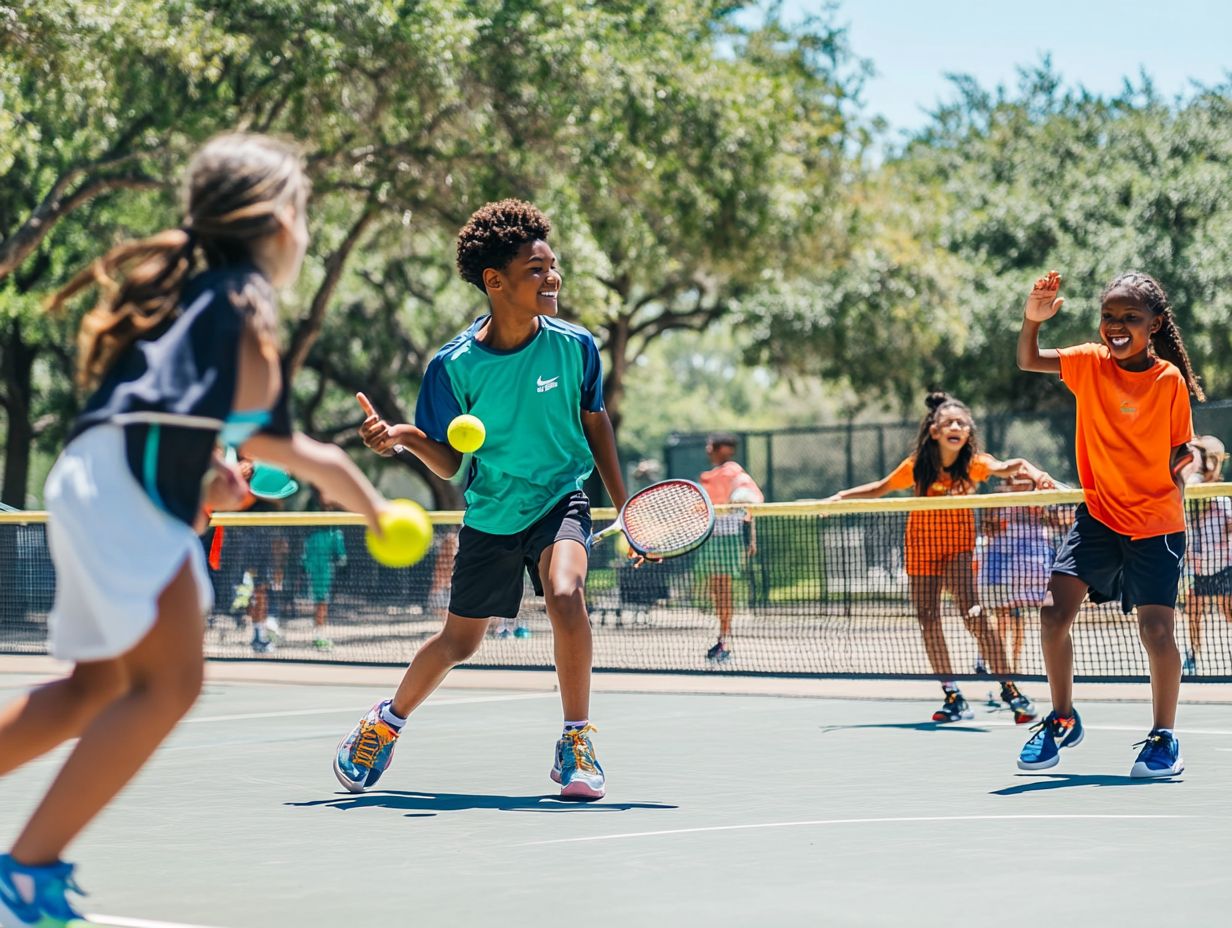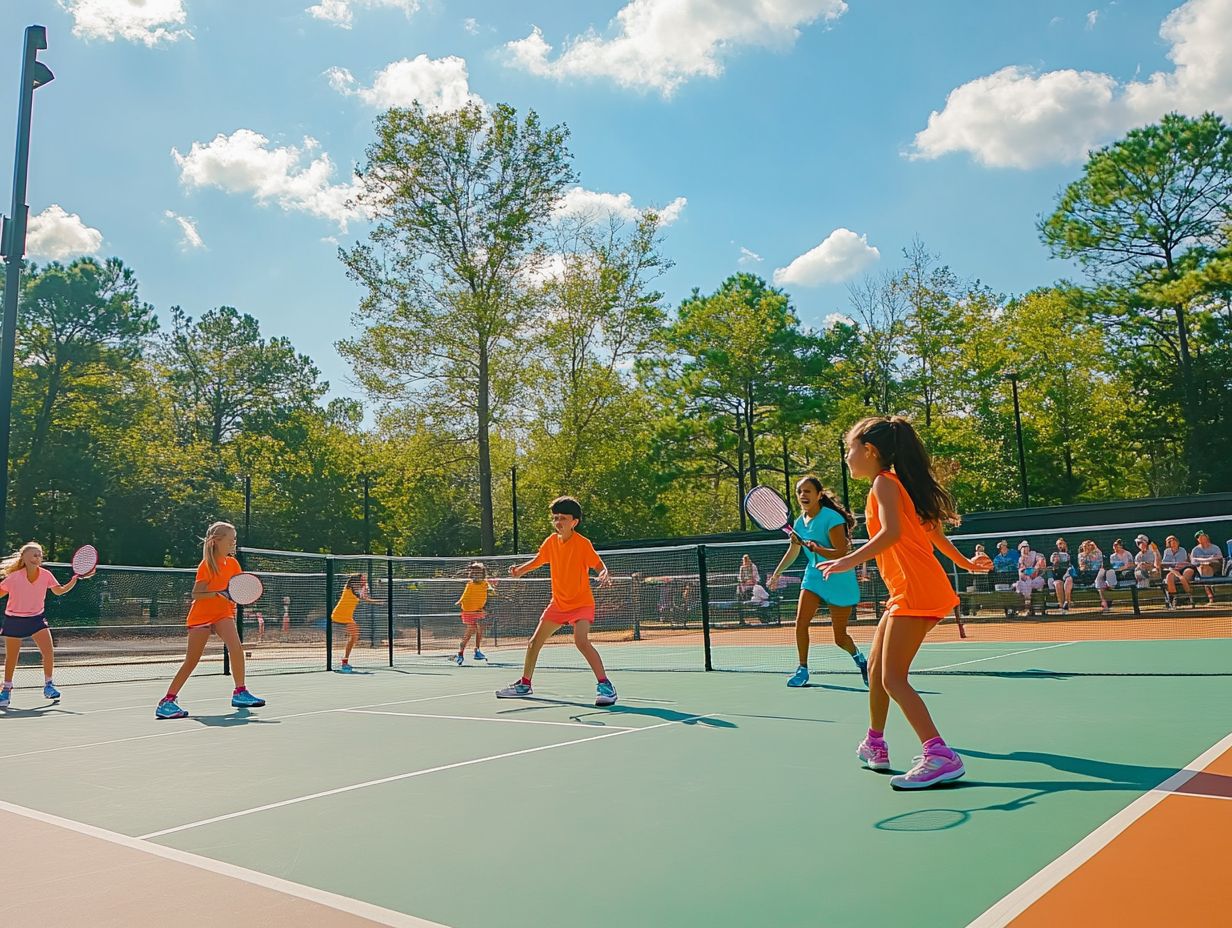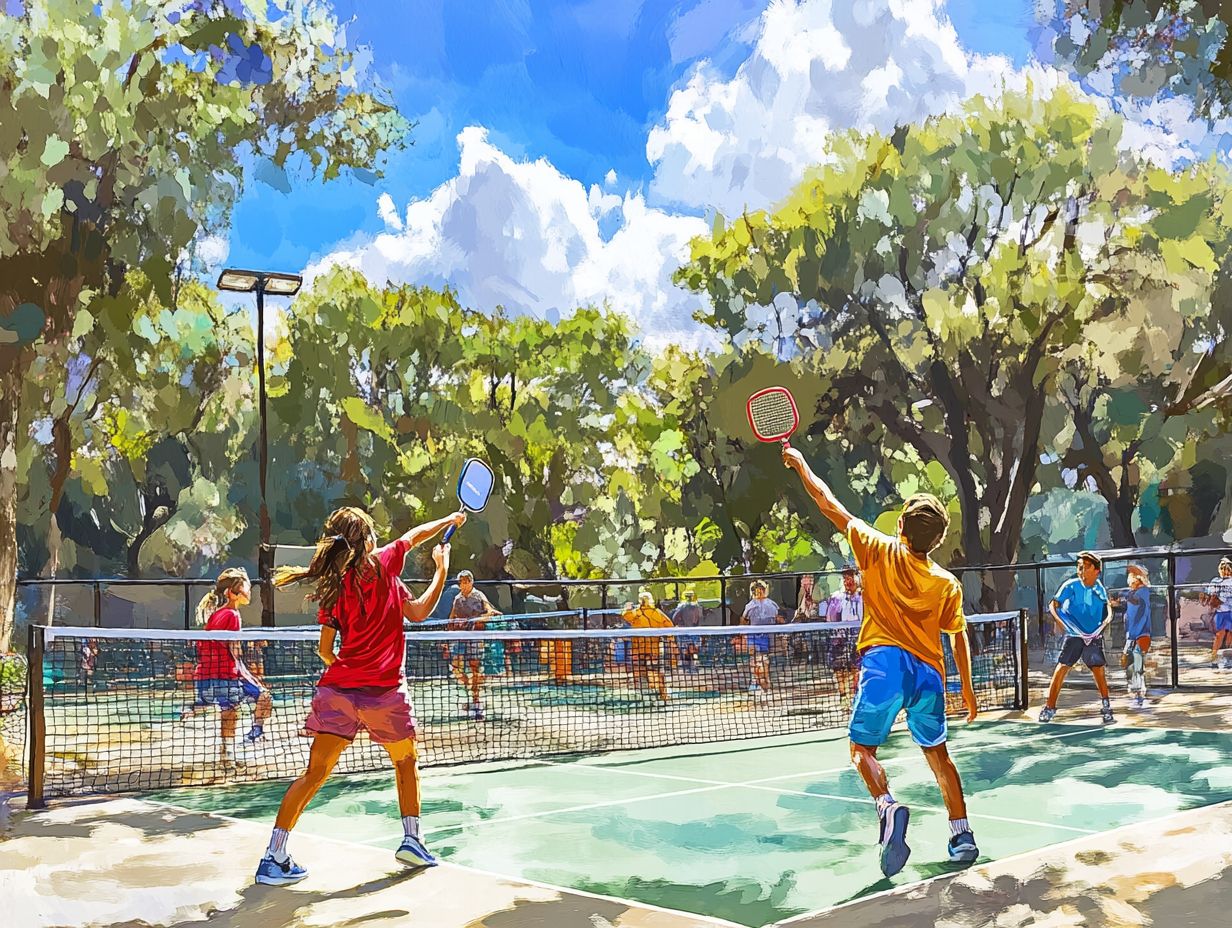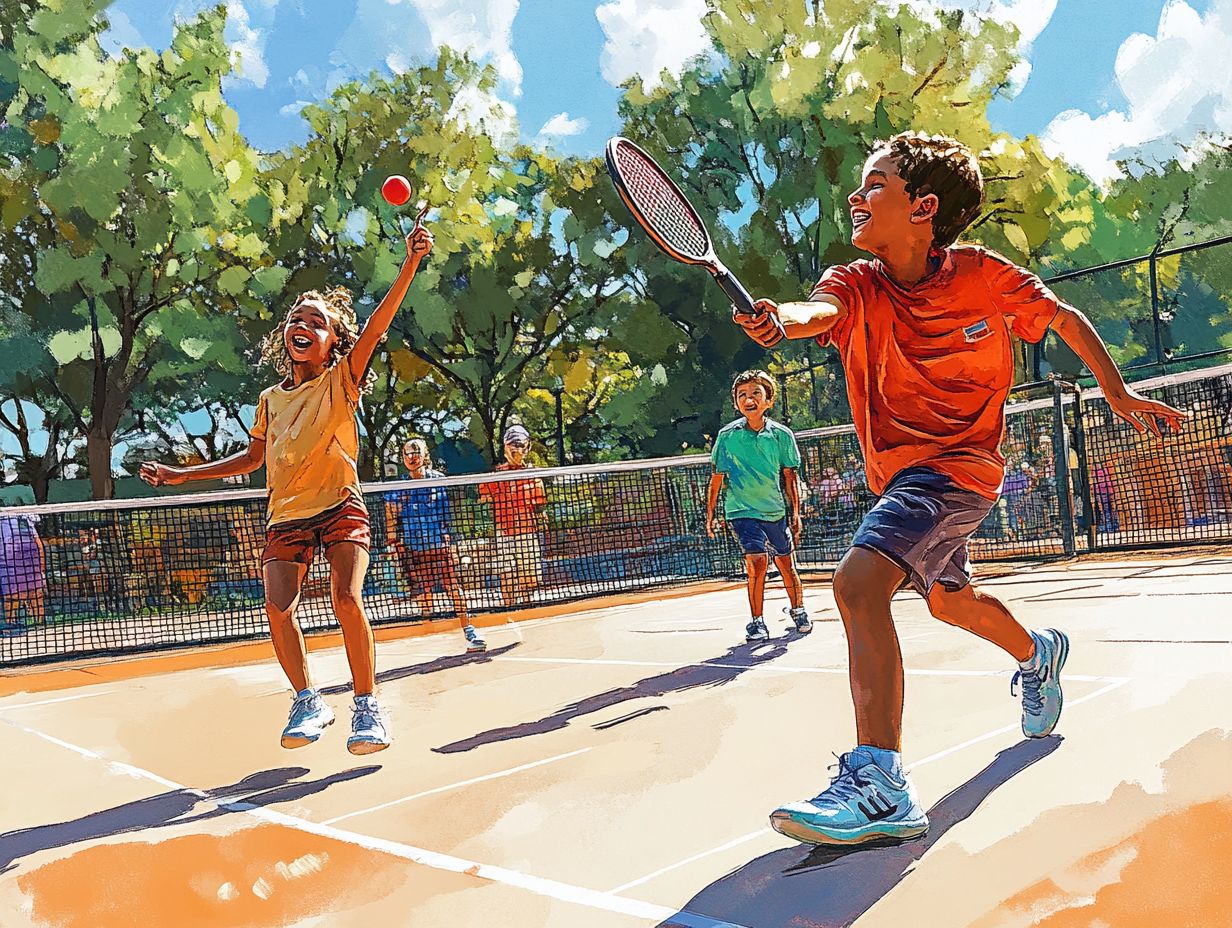Youth pickleball is rapidly emerging as one of the most exciting sports for children, and it’s easy to understand why. With its fast-paced action and social elements, pickleball not only engages young players physically but also offers numerous mental benefits.
This article examines the growing popularity of youth pickleball, effective strategies for introducing the sport to children, and training techniques to help them excel. Furthermore, it explores how to cultivate a vibrant pickleball community and what the future may hold for this dynamic sport.
Join us as we celebrate and analyze the movement that is nurturing the next generation of pickleball players!
The Rise of Youth Pickleball

Youth pickleball is becoming a prominent phenomenon in the world of recreational sports, with more young players actively engaging in the sport. This racquet sport combines elements of tennis, badminton, and ping pong, making it accessible and enjoyable for individuals of all skill levels.
As families and communities invest in youth sports programs, the popularity of pickleball has surged, leading to the establishment of local tournaments and clubs specifically designed for junior players. This growth reflects a broader trend toward community engagement and healthy lifestyles among youth, while also fostering the development of athletic skills and teamwork.
Exploring the Growing Popularity
The growing popularity of youth pickleball can be attributed to several factors, including enhanced training programs, family involvement, recreational opportunities, grassroots initiatives, youth leagues, and increased competition.
Enhanced pickleball training programs aim to equip young players with essential skills and techniques, fostering their athletic development while they enjoy the sport. Family involvement and family-friendly sports options, such as pickleball, enable parents and children to engage in healthy competition together, creating a supportive environment for learning.
Grassroots initiatives enhance the visibility and accessibility of the game, often providing communities with necessary equipment and resources. Youth leagues offer not only a platform for skill development but also opportunities for socializing and building friendships.
Collectively, these factors significantly contribute to the overall health and engagement of youth in the community by promoting active lifestyles and social interaction.
The Benefits of Youth Pickleball
Youth pickleball offers several benefits, including improved physical fitness, teamwork, and sportsmanship. This sport helps young players develop fundamental athletic skills and enhances their hand-eye coordination.
Additionally, youth pickleball provides opportunities for socializing and competition among participants. Engaging in pickleball contributes positively to the overall well-being of youngsters, making it an excellent activity for promoting active lifestyles.
Physical and Mental Benefits

The physical and mental benefits of youth pickleball make it an excellent sport for promoting agility, resilience, and motor skills among young athletes. Engaging in this fast-paced game helps players enhance their hand-eye coordination and quick decision-making abilities, which are crucial components of agility drills.
As players navigate the court, they encounter various challenges that foster mental resilience, teaching them how to handle setbacks and maintain focus under pressure. This aspect of sports psychology is vital for boosting their self-confidence and developing effective coping strategies that are beneficial in both athletic and everyday situations.
Additionally, teamwork and social interaction are essential for cultivating a positive mindset among young participants, reinforcing the importance of collaboration and perseverance.
How to Get Kids Involved in Pickleball
Introducing beginner pickleball programs specifically designed for young athletes is essential to engage children in the sport. These programs encourage family participation and promote community outreach initiatives.
By incorporating enjoyable activities that make learning fun, youth sports programs create a welcome and inviting environment for children to explore this exciting sport. Additionally, providing mentorship opportunities from experienced players can offer valuable guidance to junior players.
Introducing the Sport to Children
Selecting the right pickleball equipment, such as paddles and ensuring appropriate court dimensions for children, is essential for introducing them to the sport. This initial step promotes safety and builds confidence as they learn the mechanics of the game.
Lightweight paddles designed for youth help prevent fatigue and encourage longer play sessions. Additionally, properly setting up the playing area with clear boundaries facilitates fair play.
Breaking the rules down into small, easily digestible components aids in their understanding, allowing children to grasp the fundamentals without feeling overwhelmed. A fun learning environment that includes engaging youth outreach activities can ignite their passion for the sport, fostering a lifelong love for and participation in pickleball.
Training and Development for Young Pickleball Players

Training and development are essential for young pickleball players, as they contribute to both skill enhancement and enjoyment of the game. To achieve this, effective coaching techniques and well-structured drills and exercises are necessary.
Coaches who hold the appropriate certifications can create tailored training programs for various skill levels, ensuring that individual players can successfully advance in their athletic development.
Effective Training Techniques
The following techniques are among the most effective for training young athletes in pickleball:
- Challenger balance
- game-like or scenario-based training
- multi-directional progression
- speed and power drills
- an emphasis on fun and engagement through variety
Additionally, mental training, consistent feedback, and reinforcement play vital roles in their development. While video analysis and the use of performance indicators are more advanced techniques suited for older age groups, they can be introduced to younger players if they are capable of understanding and appreciating the added complexity.
Creating a Youth Pickleball Community
Building a vibrant youth pickleball community requires the establishment of pickleball clubs and youth leagues that promote family-friendly sports and community service initiatives. These efforts will enhance participant retention and engagement.
Organizing Tournaments and Leagues

Organizing pickleball tournaments and youth competitions provides young players with opportunities to showcase their abilities and compete in a healthy environment, while also offering volunteer opportunities that strengthen community support.
These events unite individuals from diverse backgrounds, fostering bonds and teamwork among players and their families. Adults involved in planning and executing these tournaments serve as mentors to young athletes, helping them develop important leadership skills that extend beyond the court.
The competitive atmosphere encourages players to strive for their best and promotes personal growth. Community participation ensures strong turnout and support, making the events enjoyable experiences that highlight youth skills and cultivate long-lasting friendships through the sport of pickleball.
The Future of Youth Pickleball
The future of youth pickleball looks promising, as the sport continues to grow through new youth initiatives, advancements in sports technology, and increased networking opportunities for young players.
Predictions and Opportunities
The future of youth pickleball is poised to emphasize sustainability, equity, inclusivity, and youth enablement through enjoyable and engaging activities. Understanding the history of youth pickleball is essential, as it has provided a fun pastime for many generations.
The game was first enjoyed in the 1960s when Mr. and Mrs. Joel Pritchard, a congressman from Washington State, created it on their homemade court using old equipment they had available. They repurposed an old badminton court, used paddles from their garage, and played with a perforated plastic ball that bounced and flew like a wiffle ball.
Over the years, pickleball has evolved and been refined into the sport we recognize today, creating opportunities for youth to engage in healthy competition and teamwork. This evolution supports programming that prioritizes collaboration and accessibility, allowing youth from diverse backgrounds to participate.
With the development of more eco-friendly courts and equipment, the next phase of pickleball can foster a more sustainable world, aligning with global sustainability goals. As a result, the future of youth pickleball is not only about developing athletic skills but also about nurturing a generation committed to making a positive impact.

Pickleball’s more than a game to me—it’s a passion. I write, sharing its highs and lows, the thrills and the lessons. Some tales might draw you to the court, while others give a hint of the game’s magic. So, curious about my journey? Ready to dive deep into the world of pickleball with me? Let’s go.
